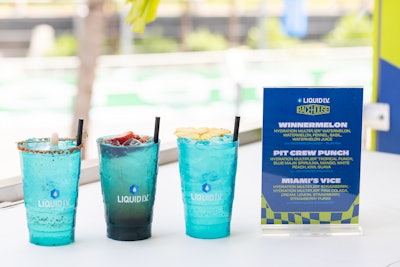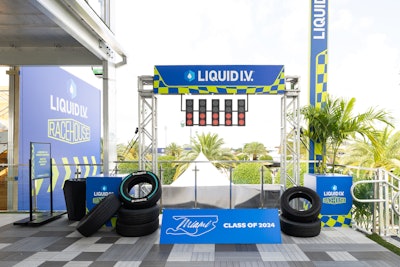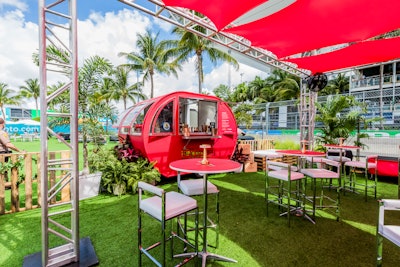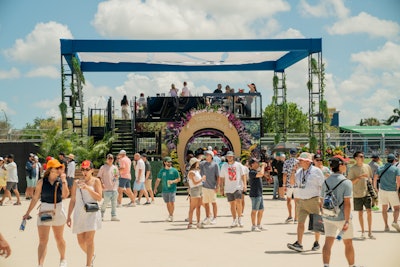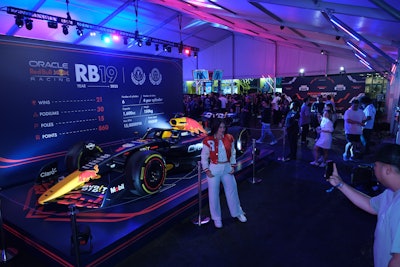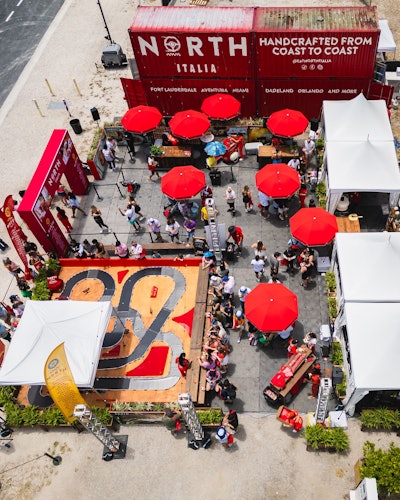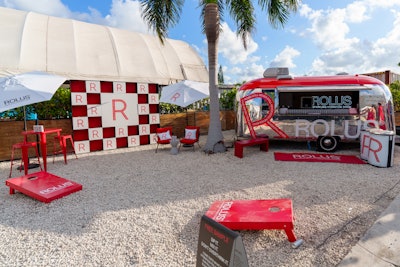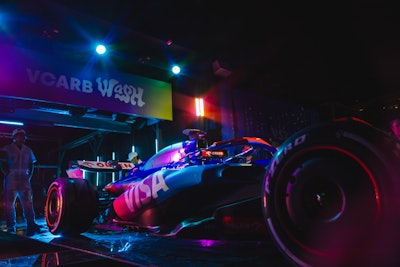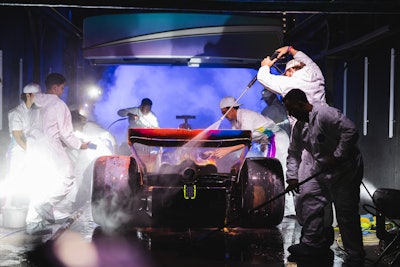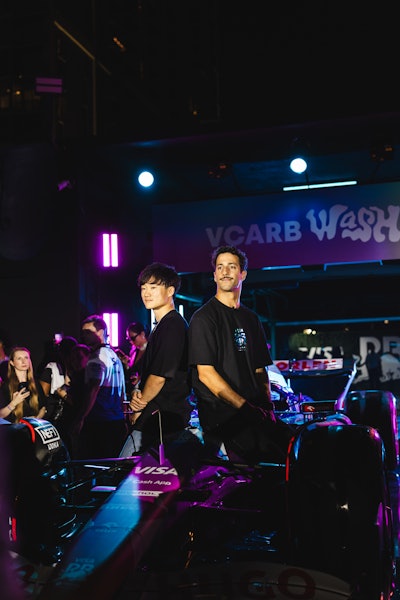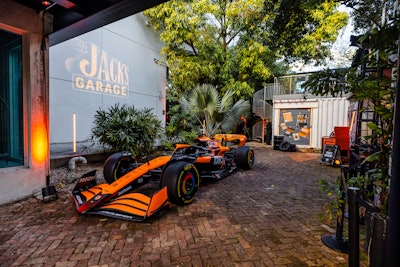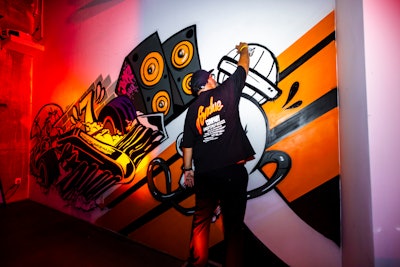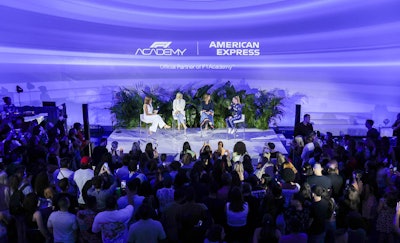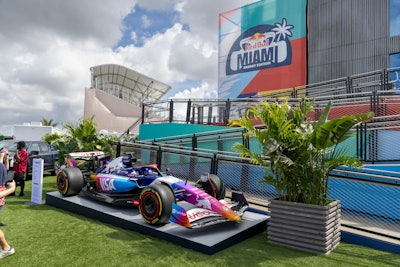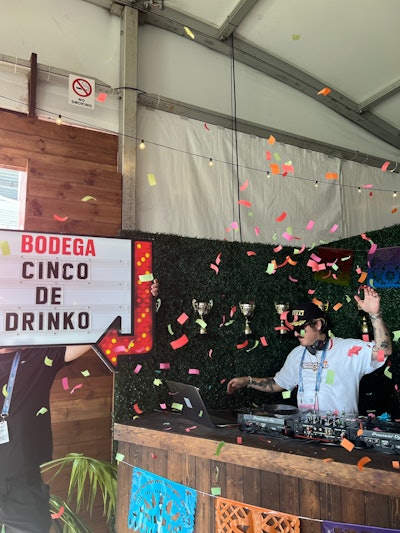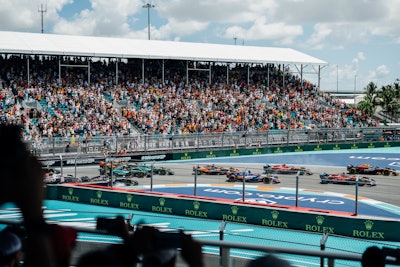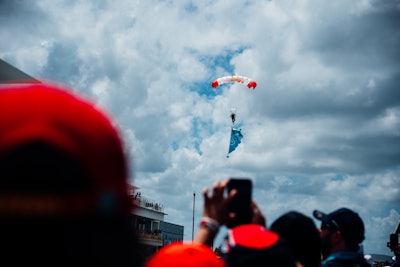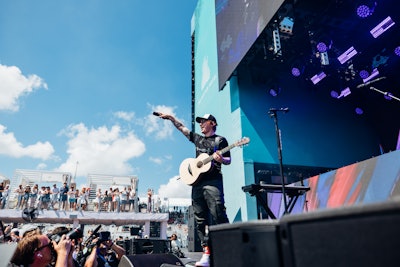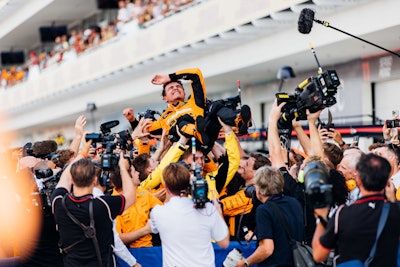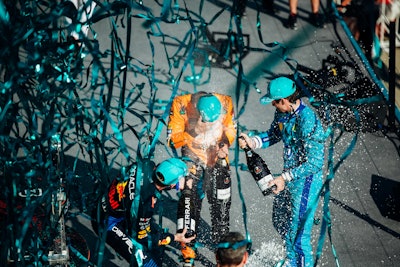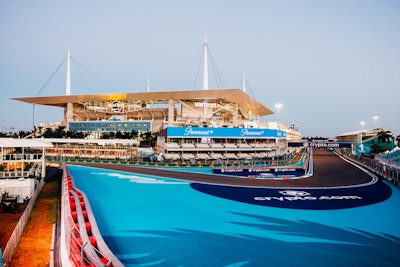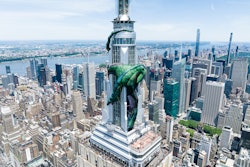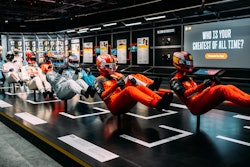 Over the course of three days, the 2024 Formula 1 Crypto.com Miami Grand Prix brought a record-breaking 275,799 spectators to the Miami International Autodrome at Hard Rock Stadium. TV ratings were also up 48% over last year’s race.Photo: Courtesy of Formula 1 Crypto.com Miami Grand Prix
Over the course of three days, the 2024 Formula 1 Crypto.com Miami Grand Prix brought a record-breaking 275,799 spectators to the Miami International Autodrome at Hard Rock Stadium. TV ratings were also up 48% over last year’s race.Photo: Courtesy of Formula 1 Crypto.com Miami Grand Prix
Sign up here to get BizBash Sports delivered straight to your inbox with steal-worthy event inspiration, top takeaways from the hottest sporting events, updates about live and virtual events, and so much more.
MIAMI—In its third installment, the three-day 2024 Formula 1 Crypto.com Miami Grand Prix brought a record-breaking 275,799 spectators to the Miami International Autodrome at Hard Rock Stadium May 3-5. TV ratings were also reported at an all-time high, peaking at 3.6 million viewers, up 48% from 2023’s race.
On Sunday, May 5, McLaren’s Lando Norris claimed victory with his first-ever Formula 1 win ahead of Oracle Red Bull Racing’s Max Verstappen and Ferrari’s Charles Leclerc. In addition to the main event, there was on-track action from Porsche Carrera Cup North America, along with the all-female F1 ACADEMY series, which put Abbi Pulling at the forefront. Plus, 23 supercars brought collectors to a special Bonhams|Cars auction Saturday night.
The star-studded attendance roster included Miami Dolphins players Jalen Ramsey and Raheem Mostert, LeBron James, Venus and Serena Williams, Jimmy Butler, Patrick Mahomes, Travis Kelce, Rory McIlroy, Kevin Durant, Shakira, Camila Cabello, and Marc Anthony, who delivered a passionate rendition of the national anthem prior to Sunday’s start.
 On Saturday, Ed Sheeran treated guests to an exclusive performance as part of the Hard Rock Beach Club’s three-day on-site music program.Photo: Courtesy of Formula 1 Crypto.com Miami Grand Prix
On Saturday, Ed Sheeran treated guests to an exclusive performance as part of the Hard Rock Beach Club’s three-day on-site music program.Photo: Courtesy of Formula 1 Crypto.com Miami Grand Prix
Entertainers across campus allowed fans to enjoy more than just the sound of revved-up engines. Hard Rock Beach Club brought a variety of performers including Ed Sheeran, Steve Aoki, John Summit, Kaskade, and Cedric Gervais, while Kaytranada delivered the official post-race podium set.
Plus, brands of all sizes and footprints appealed to the masses, including Red Bull, Liquid I.V., Piper-Heidsieck, Tequila Herradura, Chase Sapphire, Ferrari, Heineken, Paramount+, Mercedes, and High Noon.
(Continue below to peruse our gallery of activation highlights.)
Breaking Down and Building Up
Behind the scenes, the Formula 1 Crypto.com Miami Grand Prix is scheduled just one month following the close of the Miami Open, which gives new meaning to the term “all hands on deck.” In fact, Todd Boyan, senior vice president of stadium operations at Hard Rock Stadium, claims it used to take 40 days to deconstruct the Miami Open stadium court alone. “Now, we are able to complete it in 12 days with a team of people working 24 hours a day to do so,” he explains. ”This is required so we can build the team hospitality units on the stadium field in time for the Formula 1 teams to arrive on campus and set up for the race.”Boyan says there are more than 1,000 people on site each day to help with the transition. Hard Rock Stadium manages three crews to work simultaneously in building the F1 team units. Two crews are responsible for assembling four units each, while the third assembles a total of five units. During the Miami Open load out in April, the crews work to preassemble arches and beams in the parking lot to initiate the process. All units are built from the ground up starting with base plates and followed by aluminum columns.
 Formula 1 takes place just one month after the close of the Miami Open. However, builds for both events begin as soon as the Miami Dolphins' NFL season concludes. About 40% of the Formula 1 barriers and grandstands are completed before the Miami Open, 20% during, and the remaining 40% is finished after the end of the professional tennis tournament.Photo: Courtesy of Formula 1 Crypto.com Miami Grand Prix
Formula 1 takes place just one month after the close of the Miami Open. However, builds for both events begin as soon as the Miami Dolphins' NFL season concludes. About 40% of the Formula 1 barriers and grandstands are completed before the Miami Open, 20% during, and the remaining 40% is finished after the end of the professional tennis tournament.Photo: Courtesy of Formula 1 Crypto.com Miami Grand Prix
According to Boyan, the planning for Formula 1 begins 10 months before the race, and the physical build for both the Miami Open and Formula 1 begins as soon as the Miami Dolphins' NFL season concludes. To break it down further, in terms of barriers and grandstands for the Formula 1 track, 40% is completed before the Miami Open, 20% during, and the remaining 40% is completed after the end of the tournament.
“We are fortunate to have a stadium operations team that is accustomed to large-scale turnover between events, but there is no project we take on quite as large as building the Miami Open stadium court and grandstand, and then taking it down in time to build the Team Village for the Miami Grand Prix,” Boyan shares. “We have to be strategic in the way we carry on the construction and load in for Formula 1 so that we ensure guests coming to the Miami Open continue to have a terrific experience at a world-class tennis tournament [during the simultaneous build].”
Finding Synergy
Overlapping elements from the Miami Open to Formula 1 take some of the load off, including The Fountains, which is on the south side of the stadium. “This area stays largely the same—including many of the same F&B vendors and all the same temporary structures—from Miami Open to Formula 1,” Boyan says. “It has always been the primary gathering point for Miami Open general admission fans. And this year, we saw it really become a hub for campus pass holders to gather and watch the F1 race, as well as the post-race entertainment. It’s great to see that kind of synergy in the same space from one event to the next.” McLaren driver Lando Norris celebrates his first Formula 1 win following his 110th start in the sport. Norris was the first competitor to beat reigning world champion Max Verstappen, who won the past two consecutive Miami Grand Prix races.Photo: Courtesy of Formula 1 Crypto.com Miami Grand Prix
McLaren driver Lando Norris celebrates his first Formula 1 win following his 110th start in the sport. Norris was the first competitor to beat reigning world champion Max Verstappen, who won the past two consecutive Miami Grand Prix races.Photo: Courtesy of Formula 1 Crypto.com Miami Grand Prix
Other structures that served both events this year included: Race House; Terrace; Palm/72 Club; Bodega Taqueria y Tequila; Piper-Heidsieck Champagne Garden; Editor Pizza; and the pedestrian bridges at turns 1, 3, and 9. “As we plan for one event, we always do so with the lens of how it affects the next one—and even more so, how we can build off of one to the next in positive and complementary ways.”
Investing in Improvements
As with any event, there are always challenges and constraints to overcome, even at a grandiose spectacle with the caliber of the Formula 1 Crypto.com Miami Grand Prix. Boyan says in year one, it was more than just the very tight timeline of 11 months to build and sell everything, the pressure of global supply chain instability, and managing around other large-scale events for the first time. “We delivered a great event despite those challenges but certainly had areas to improve on,” he admits. “We sought feedback from our guests and partners and invested heavily in addressing those concerns for year two.”This started with the $130 million, state-of-the-art permanent Paddock Club building with DO & CO to provide the catering. Next came the expansion of the Paddock, creating a Team Village on the Dolphins football field to allow teams and drivers more space to operate where general admission fans could sit in the 300 level of the stadium and watch drivers move about the Paddock.
 Brands like Flor de Caña rum reserved suites within the exclusive Paddock Club’s garden level and rooftop, which allowed them to treat VIP guests to micro pop-ups with swag, in addition to finish-line race views, world-class amenities, and upscale bites and beverages. Suites were outfitted in tropical decor as a nod to the host city.Photo: Courtesy of Formula 1 Crypto.com Miami Grand Prix
Brands like Flor de Caña rum reserved suites within the exclusive Paddock Club’s garden level and rooftop, which allowed them to treat VIP guests to micro pop-ups with swag, in addition to finish-line race views, world-class amenities, and upscale bites and beverages. Suites were outfitted in tropical decor as a nod to the host city.Photo: Courtesy of Formula 1 Crypto.com Miami Grand Prix
“That’s a unique aspect of our campus and an example of how we try to use our stadium in creative ways to make it the best possible fan experience,” says Boyan. “We saw even more fans congregate on the 300 level this year to take in the action.” Appeasing the fans was also behind the decision to build more shaded structures to combat the harsh sun, dining tables, and restrooms, and wider pedestrian bridges to assist with foot traffic flow. “We have received a lot of positive feedback from the changes we have made and will continue to innovate and improve.”
It’s not just about the fans and VIPs, though; Boyan and Formula 1 also heard the drivers loud and clear. “We also repaved the track heading into year two based on the feedback we received from teams and drivers, and that has proven to be a great investment as we’ve seen more overtaking and this year, the most competitive race of the season to date!”
What’s Next
With seven more years to go on the current 10-year Formula 1 contract, Hard Rock Stadium is already reaping the benefits of playing host to the first U.S.-based race of the year, ahead of Austin in October and Las Vegas in November.“Stephen Ross and Tom Garfinkel had a vision to turn Hard Rock Stadium into a global entertainment destination, and through their leadership and investment, that is what we have done,” shares Boyan. “Adding Formula 1 to our calendar has only elevated the stadium—it is the highest level of motor sport competition hosted in a city that is known for its culture, sports, and entertainment. As Formula 1 continues to grow in the U.S., it’s a perfect fit for Hard Rock Stadium. We work very hard to bring in the best acts in sports and entertainment to our venue. Formula 1 is an international sport with massive reach, and it has elevated our venue to new audiences, partners, and fans.”
 Lando Norris, Max Verstappen, and Charles Leclerc kicked off the Miami Grand Prix after-party with a Ferrari Brut sparkling wine spray and confetti streamers.Photo: Courtesy of Formula 1 Crypto.com Miami Grand Prix
Lando Norris, Max Verstappen, and Charles Leclerc kicked off the Miami Grand Prix after-party with a Ferrari Brut sparkling wine spray and confetti streamers.Photo: Courtesy of Formula 1 Crypto.com Miami Grand Prix
But Boyan and his team aren’t quite ready for rest. In fact, they’ve already started transforming the stadium for Copa America, with a match slated as soon as June 29, and the Finals on July 14. And there’s plenty of pitch to purpose; planning has already begun for the prestigious task of co-hosting the 2026 FIFA World Cup. “We will be under a very tight timeline in 2026 to transform the stadium from Formula 1 to the World Cup, which is why this year’s transition [into Copa America] is so important for us to make sure we get it right and take any learnings to improve for the future.”
Until then, take some time to peruse the on-track highlights from this year’s Formula 1 Crypto.com Miami Grand Prix and associated Miami Race Week events that took place around the Magic City...
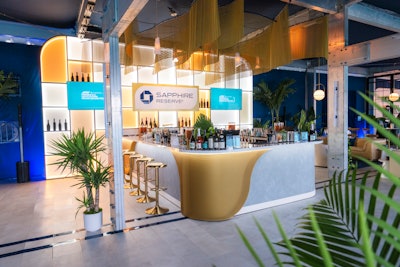
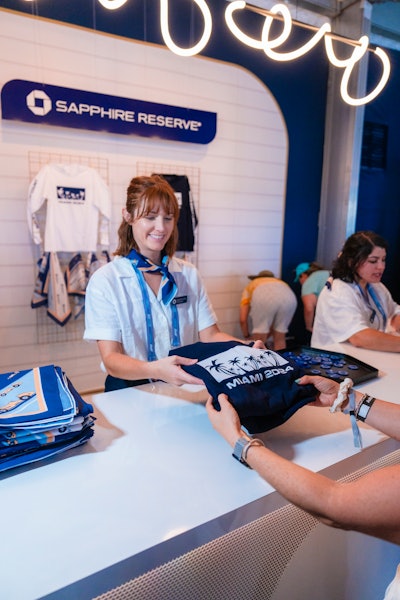
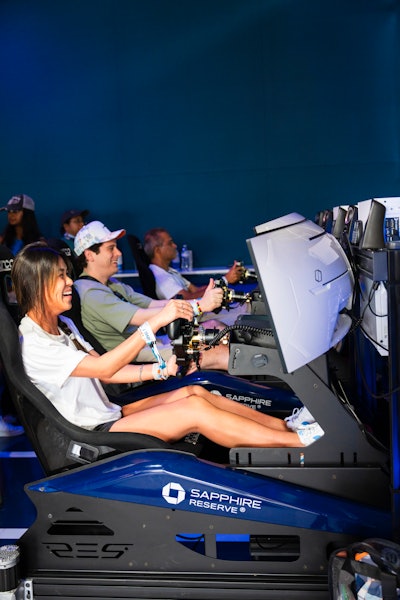
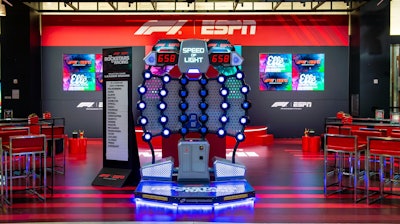
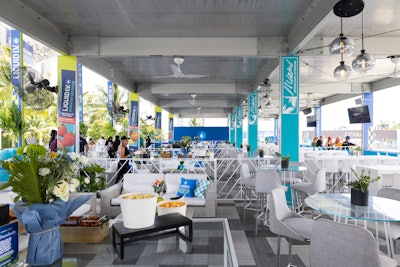
“We worked with NVE Experience Agency to craft our standout activation on campus, the Liquid I.V. Race House, a multilevel destination that offered premium hospitality inclusive of a ‘Race to Hydration’ simulator game, branded giveaways, and a front-row view to all the on-track action,” shares Stacey Andrade-Wells, vice president of marketing at Liquid I.V.
